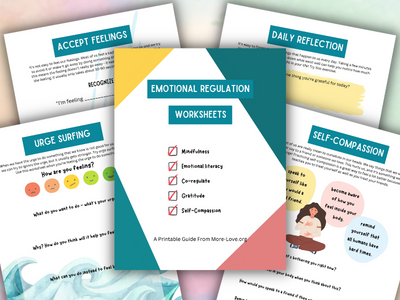
Many parents find themselves at the crossroads of an eating disorder and a drinking problem. The disorders are linked and often seen together. So how can a parent help?
- Understand why your child has an eating disorder and a drinking problem
- Learn the steps to recovery
- Support your child’s recovery
Many people who have eating disorders also have a problem with alcohol use disorders. It helps to understand the correlation between alcohol and eating disorders. This requires looking closely at the true reason for disordered behavior.
1. Understand why your child has an eating disorder and a drinking problem
Let’s start by understanding why your child has an eating disorder and a drinking problem.
Eating disorders typically involve an obsession and compulsion with eating and exercise behaviors. Similarly, alcohol and drinking also involve obsession and compulsion.
Emotional Regulation Worksheets
Give these printable worksheets to grow more confident, calm and resilient and feel better, fast!
- Self-Esteem
- Self-Regulation
- Mindfulness
- Calming strategies
Both of these conditions can be seen as ways to regulate emotions. The unconscious drive may be to protect against uncomfortable feelings and emotions. Both eating disorders and drinking can be a way to avoid feelings of anger, loneliness, anxiety, and depression. They can be a way to feel less unhappy, lonely, or stressed.
Some facts about drinking
- By age 15, about 33 percent of teens have had at least 1 drink.
- By age 18, about 60 percent of teens have had at least 1 drink.
- In 2015, 7.7 million young people ages 12–20 reported that they drank alcohol beyond “just a few sips” in the past month.
- 5.1 million young people reported binge drinking (for males 5 or more drinks and for females 4 or more drinks on the same occasion within a few hours) at least once in the past month.
- 1.3 million young people reported binge drinking on 5 or more days over the past month.
Eating disorders and alcohol use can create a vicious cycle. The person avoids uncomfortable feelings and doesn’t develop healthy coping mechanisms. Instead of learning to process stress and discomfort, people who have eating disorders and drinking problems rely on coping behaviors.
People who have eating disorders and problems with alcohol have common personality traits. These include sensitive dispositions, anxiety and perfectionism. These traits are often considered the foundation on which eating disorders and alcoholism are founded.
The signs of eating disorder and a drinking problem are very similar
- Changes in mood, including anger and irritability
- Academic and/or behavioral problems in school
- Rebelliousness
- Changing groups of friends
- Low energy level
- Less interest in activities
- Problems concentrating and/or remembering
- Coordination problems
People who have eating disorders and alcohol problems tend to use more even when they can see that it’s working against them. They may feel tremendous remorse and regret and promise to stop drinking forever, only to begin again later that same day. The notable exception to this is anorexia, which is “egosystonic” or fits the person’s view of themselves. While most other eating disorders and problem drinking are “egodystonic” and lead to feelings of shame, anorexia feels in-keeping with the person’s identity.
For example, someone who has bulimia may wake up feeling disgusted by their binge and purge episode the night before. They feel ashamed of their need for this devastating behavior and promise to stop. They start out being “good” by restricting food the next day. But they will likely return to binging and purging at night.
Regardless, both the person with the eating disorder and the person with alcohol addiction feels compelled to continue doing it.
The known contributors to eating disorders and problem drinking are very similar
- Genetics
- Social factors, such as media and advertising or the influence of peers
- Family dynamics
- Accessibility
- High stress
- Depression
- Anxiety disorder
- Abuse, neglect, or other traumatic experiences in childhood
Just like with eating disorders, trauma is highly linked to substance use disorders. In fact up to 70% of adolescents who are being treated for substance use disorders have a history of trauma. Teenagers who are exposed to physical or sexual abuse are even more likely (3x) to struggle with substances. And more than half of teens who have been diagnosed with Post Traumatic Stress Disorder (PTSD) develop substance use problems.
With all of this information, it’s important for parents to understand why these disorders arise. We often focus on the psychology of eating disorders and alcohol use without thinking about the underlying causes. However, when we pay attention to the causes of eating disorders and alcohol dependency, we can treat them with greater results.
2. Learn the steps to recovery
Now that you understand why your child has an eating disorder and a drinking problem, it’s time to look at recovery.
It makes sense to want to stop the behavior right away. But it’s important not to lose sight of how difficult this will be without learning new skills. And new skills require practice and reinforcement. Therefore, we like to look at recovery as having three parts:
- Stopping the behavior: in this part, your child learns to live without their eating disorder behaviors and drinking. This may happen in an inpatient treatment center or at home. Many treatment approaches tackle this first. This is especially important if weight suppression is an issue. It will be hard to recover from an eating disorder when weight suppressed as it has physical and mental complications.
- Learning emotional regulation: people who have eating disorders and drinking problems have trouble with emotional regulation. Emotional dysregulation is normal and natural. It’s a physiological response to stressors. Your child was using an eating disorder and drinking to regulate their emotions. So now they need to learn new skills.
- Practice and reinforcement: traditional treatment usually ends before a person is fully recovered. Recovery can be practiced and reinforced at home. But many times a person returns to an unchanged environment. In these cases we know they are likely to pick up their old patterns and behaviors.
As you can see, the third stage of recovery is critical for ongoing success. And it’s primarily something that’s done at home with parents. This gets us to the next part …
Emotional Regulation Worksheets
Give these printable worksheets to grow more confident, calm and resilient and feel better, fast!
- Self-Esteem
- Self-Regulation
- Mindfulness
- Calming strategies
3. Support your child’s recovery
You can support your child’s recovery at home by making some changes. Your main role is in the practice and reinforcement part of recovery. For instance, here’s what this might look like for someone who has an eating disorder and a drinking problem:
- Parents learn emotional co-regulation to help their child calm down when dysregulated
- Alcohol is removed from the home and nobody in the house drinks around the child
- Dieting is not allowed in the home. And nobody in the house talks about weight or labels food as good or bad
- The family regularly talks about and learns about the dangers of drinking and dieting. They take action to reduce harm in their community
- Parents address issues in the family dynamics that may contribute to stress. For example, treating siblings appropriately, maintaining healthy family leadership, the parental role, etc.
- The family focuses on building connection and belonging. In other words, they spend time talking and spending time together
Each family will do this a little bit differently. There is no one-size-fits all solution for eating disorders and alcoholism. But one thing is clear: parents should get help and support. Parents can can learn and grow and support their kids through recovery. If you’re facing this, consider getting a therapist or coach who can guide you.

Ginny Jones is the founder of More-Love.org, and a Parent Coach who helps parents who have kids with disordered eating and eating disorders. Combining science, compassion, and experience coaching hundreds of families, she helps parents understand what’s going on with their kids’ eating behaviors and teaches them the science-backed skills to heal kids’ relationship with food, improve their body image, and feel better about themselves, their relationships, and life in general.
Ginny has been researching and writing about eating disorders since 2016. She incorporates the principles of neurobiology and attachment parenting with a non-diet, Health At Every Size® approach to health and recovery.
See Our Parent’s Guide To Mental Health And Eating Disorders
References
Alcohol Use Disorder Comorbidity in Eating Disorders: A Multicenter Study
How do eating disorders and alcohol use disorder influence each other?
Eating Disorders and Addictions Cause a Deadly Combination
Alcohol and Trauma: Drinking as a Way to Cope with the Past


